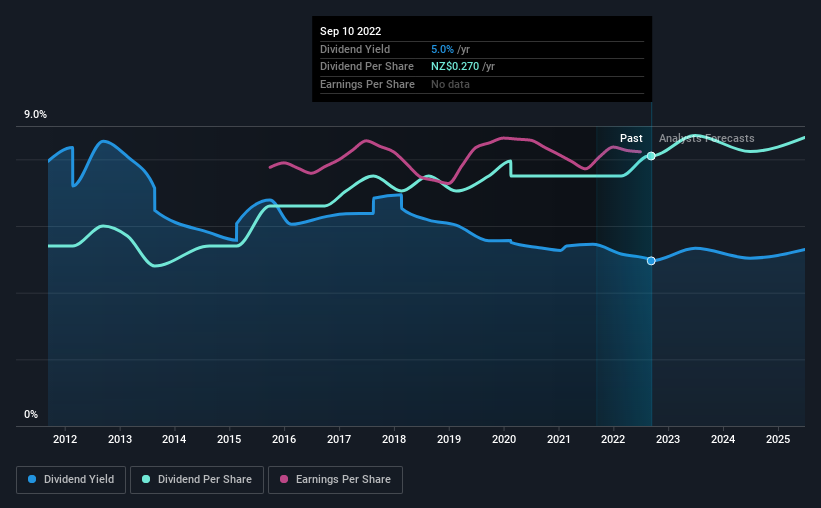- New Zealand
- /
- Telecom Services and Carriers
- /
- NZSE:SPK
Don't Race Out To Buy Spark New Zealand Limited (NZSE:SPK) Just Because It's Going Ex-Dividend

It looks like Spark New Zealand Limited (NZSE:SPK) is about to go ex-dividend in the next 4 days. The ex-dividend date is usually set to be one business day before the record date which is the cut-off date on which you must be present on the company's books as a shareholder in order to receive the dividend. The ex-dividend date is of consequence because whenever a stock is bought or sold, the trade takes at least two business day to settle. In other words, investors can purchase Spark New Zealand's shares before the 15th of September in order to be eligible for the dividend, which will be paid on the 7th of October.
The company's next dividend payment will be NZ$0.15 per share, on the back of last year when the company paid a total of NZ$0.27 to shareholders. Based on the last year's worth of payments, Spark New Zealand has a trailing yield of 5.0% on the current stock price of NZ$5.45. Dividends are a major contributor to investment returns for long term holders, but only if the dividend continues to be paid. As a result, readers should always check whether Spark New Zealand has been able to grow its dividends, or if the dividend might be cut.
Check out our latest analysis for Spark New Zealand
Dividends are typically paid out of company income, so if a company pays out more than it earned, its dividend is usually at a higher risk of being cut. Spark New Zealand distributed an unsustainably high 114% of its profit as dividends to shareholders last year. Without extenuating circumstances, we'd consider the dividend at risk of a cut. Yet cash flow is typically more important than profit for assessing dividend sustainability, so we should always check if the company generated enough cash to afford its dividend. Over the past year it paid out 110% of its free cash flow as dividends, which is uncomfortably high. We're curious about why the company paid out more cash than it generated last year, since this can be one of the early signs that a dividend may be unsustainable.
As Spark New Zealand's dividend was not well covered by either earnings or cash flow, we would be concerned that this dividend could be at risk over the long term.
Click here to see the company's payout ratio, plus analyst estimates of its future dividends.

Have Earnings And Dividends Been Growing?
Stocks with flat earnings can still be attractive dividend payers, but it is important to be more conservative with your approach and demand a greater margin for safety when it comes to dividend sustainability. If earnings decline and the company is forced to cut its dividend, investors could watch the value of their investment go up in smoke. It's not encouraging to see that Spark New Zealand's earnings are effectively flat over the past five years. Better than seeing them fall off a cliff, for sure, but the best dividend stocks grow their earnings meaningfully over the long run.
Many investors will assess a company's dividend performance by evaluating how much the dividend payments have changed over time. In the past 10 years, Spark New Zealand has increased its dividend at approximately 4.1% a year on average.
To Sum It Up
Is Spark New Zealand worth buying for its dividend? It's been unable to generate earnings growth, yet is paying out an uncomfortably high percentage of both its profits (114%) and cash flow (110%) as dividends. It's not that we think Spark New Zealand is a bad company, but these characteristics don't generally lead to outstanding dividend performance.
Although, if you're still interested in Spark New Zealand and want to know more, you'll find it very useful to know what risks this stock faces. To that end, you should learn about the 3 warning signs we've spotted with Spark New Zealand (including 1 which is concerning).
A common investing mistake is buying the first interesting stock you see. Here you can find a full list of high-yield dividend stocks.
If you're looking to trade Spark New Zealand, open an account with the lowest-cost platform trusted by professionals, Interactive Brokers.
With clients in over 200 countries and territories, and access to 160 markets, IBKR lets you trade stocks, options, futures, forex, bonds and funds from a single integrated account.
Enjoy no hidden fees, no account minimums, and FX conversion rates as low as 0.03%, far better than what most brokers offer.
Sponsored ContentNew: Manage All Your Stock Portfolios in One Place
We've created the ultimate portfolio companion for stock investors, and it's free.
• Connect an unlimited number of Portfolios and see your total in one currency
• Be alerted to new Warning Signs or Risks via email or mobile
• Track the Fair Value of your stocks
Have feedback on this article? Concerned about the content? Get in touch with us directly. Alternatively, email editorial-team (at) simplywallst.com.
This article by Simply Wall St is general in nature. We provide commentary based on historical data and analyst forecasts only using an unbiased methodology and our articles are not intended to be financial advice. It does not constitute a recommendation to buy or sell any stock, and does not take account of your objectives, or your financial situation. We aim to bring you long-term focused analysis driven by fundamental data. Note that our analysis may not factor in the latest price-sensitive company announcements or qualitative material. Simply Wall St has no position in any stocks mentioned.
About NZSE:SPK
Spark New Zealand
Provides telecommunications and digital services in New Zealand.
Average dividend payer with mediocre balance sheet.
Similar Companies
Market Insights
Community Narratives




